Abstract
The metabolic clearance rate (MCR) and blood production rate (BP) of testosterone (T) and dihydrotestosterone (DHT), the conversion of plasma testosterone to plasma dihydrotestosterone, and the renal clearance of androstenedione, testosterone, and dihydrotestosterone have been studied in man. In eight normal men, the MCRT (516±108 [SD] liters/m2/day) was significantly greater than the MCRDHT (391±71 [SD] liters/m2/day). In seven females, the MCRT (304±53 [SD] liters/m2/day) was also greater than the MCRDHT (209±45 [SD] liters/m2/day) and both values were less than their respective values in men (P < 0.001). In men the conversion of testosterone into dihydrotestosterone at 2.8±0.3% (SD) was greater than that found in females, 1.56±0.5% (SD) (P < 0.001). In five pregnant females the MCRT (192±36 [SD] liters/m2/day), the MCRDHT (89±30 [SD] liters/m2/day) and the conversion of testosterone into dihydrotestosterone (0.72±0.15%) (SD) were significantly less than the values found in nonpregnant women. In five females with hyperthyroidism, the MCR for testosterone and dihydrotestosterone were similar to those observed in pregnant females, but the conversion of testosterone into dihydrotestosterone (2.78±1.7%) (SD) was greater, and similar to that found in men. In men the production of dihydrotestosterone was 0.39±0.1 (SD) mg/day, 50% being derived from the transformation of plasma testosterone. In women the production of DHT was 0.05±0.028 (SD) mg/day, only 10% coming from testosterone. During pregnancy, the production of testosterone and dihydrotestosterone are similar to that in normal women. In three patients with testicular feminization syndrome (an adult with hyperthyroidism and two children) these two MCRs were greatly reduced compared to the normal females, but the conversion of testosterone into dihydrotestosterone was in the limits of normal male range
In the normal subjects the renal clearance of androstenedione was greater than that of testosterone and dihydrotestosterone. Less than 20% of the dihydrotestosterone and less than 10% of the androstenedione in the urine is derived from the plasma dihydrotestosterone and androstenedione.
Full text
PDF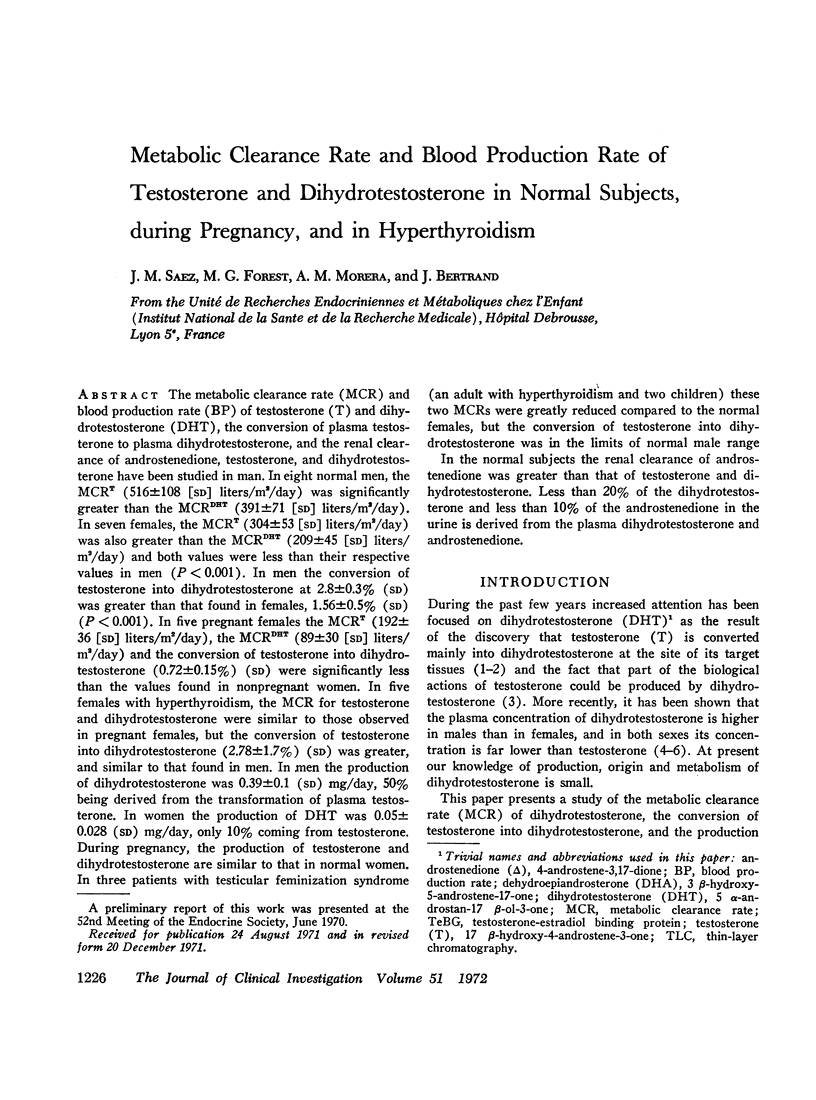
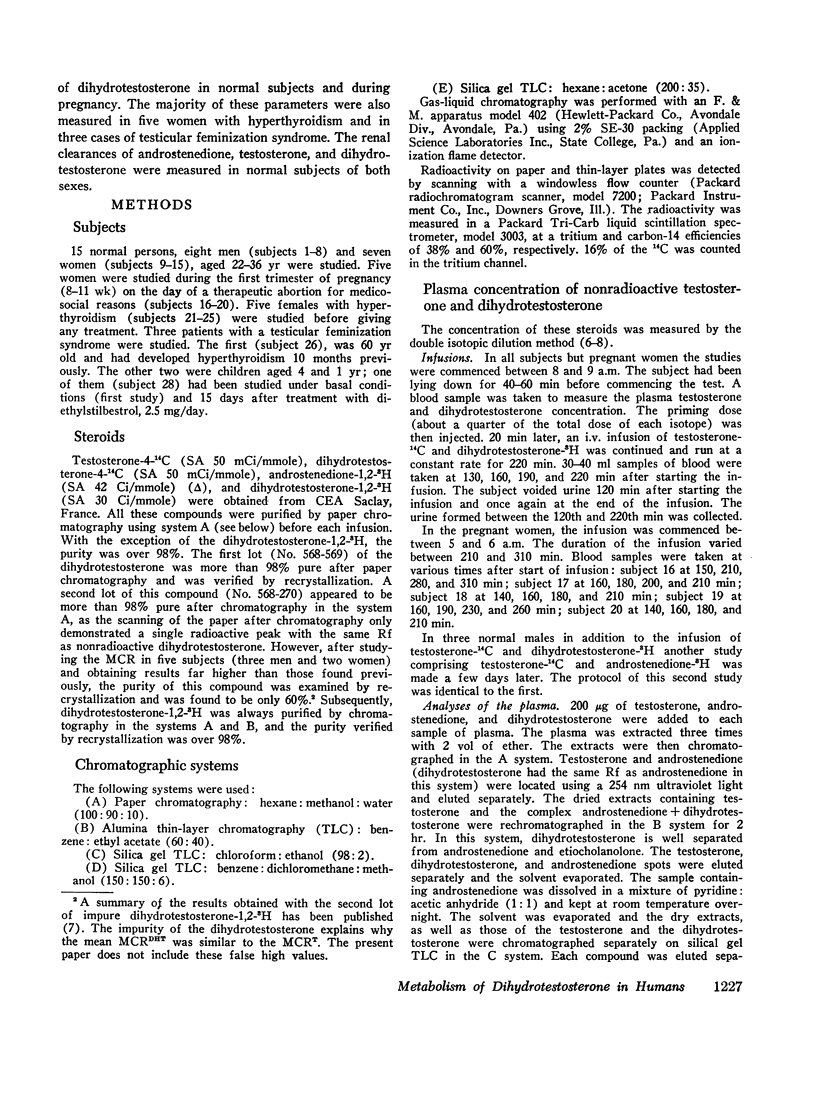
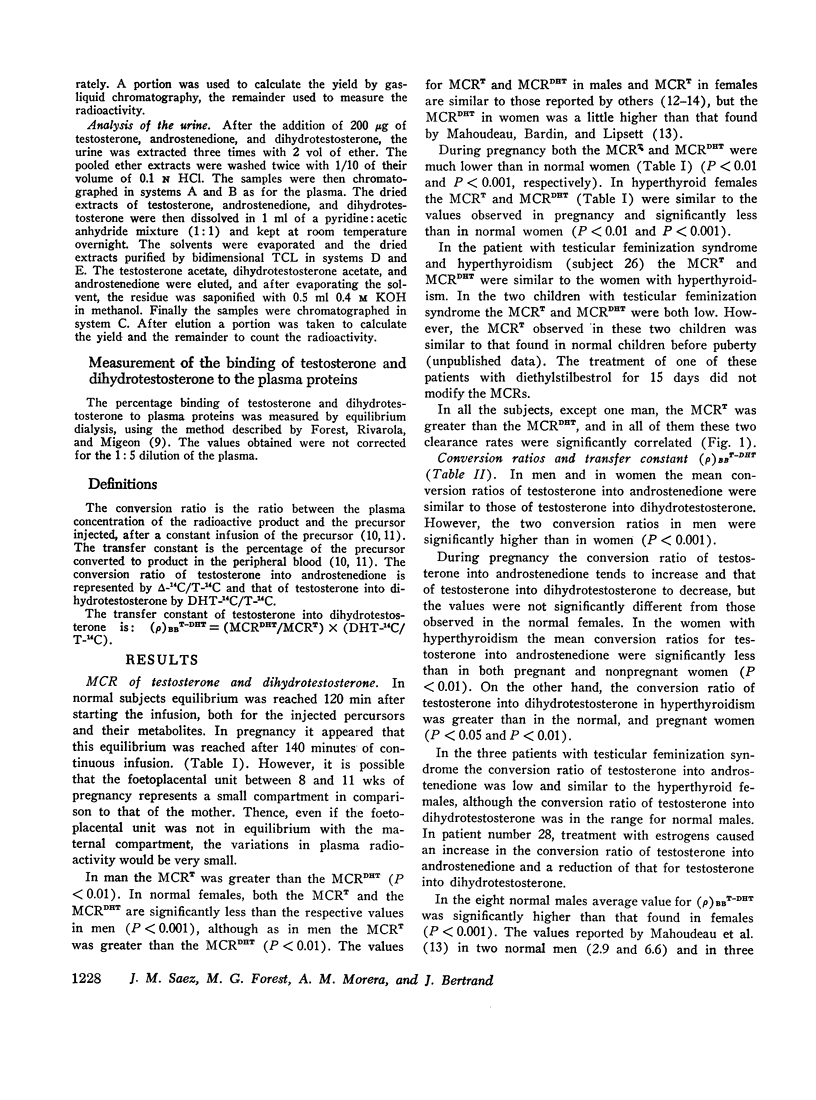
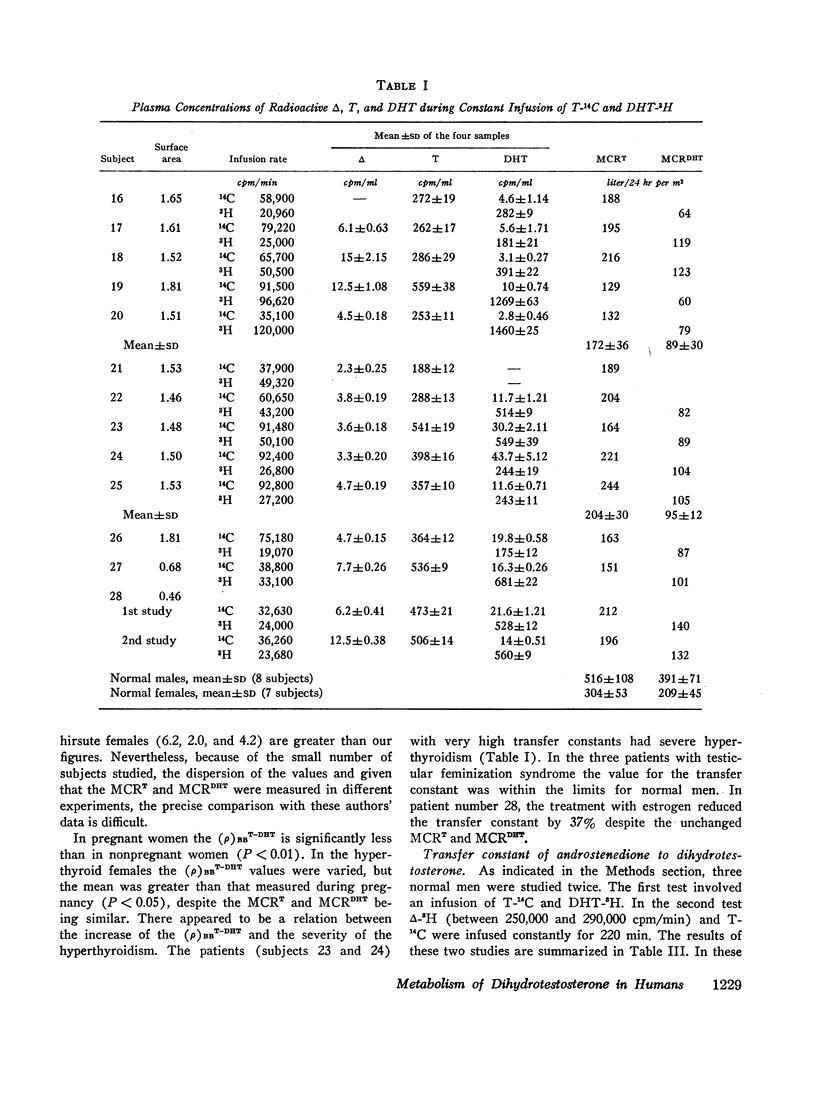
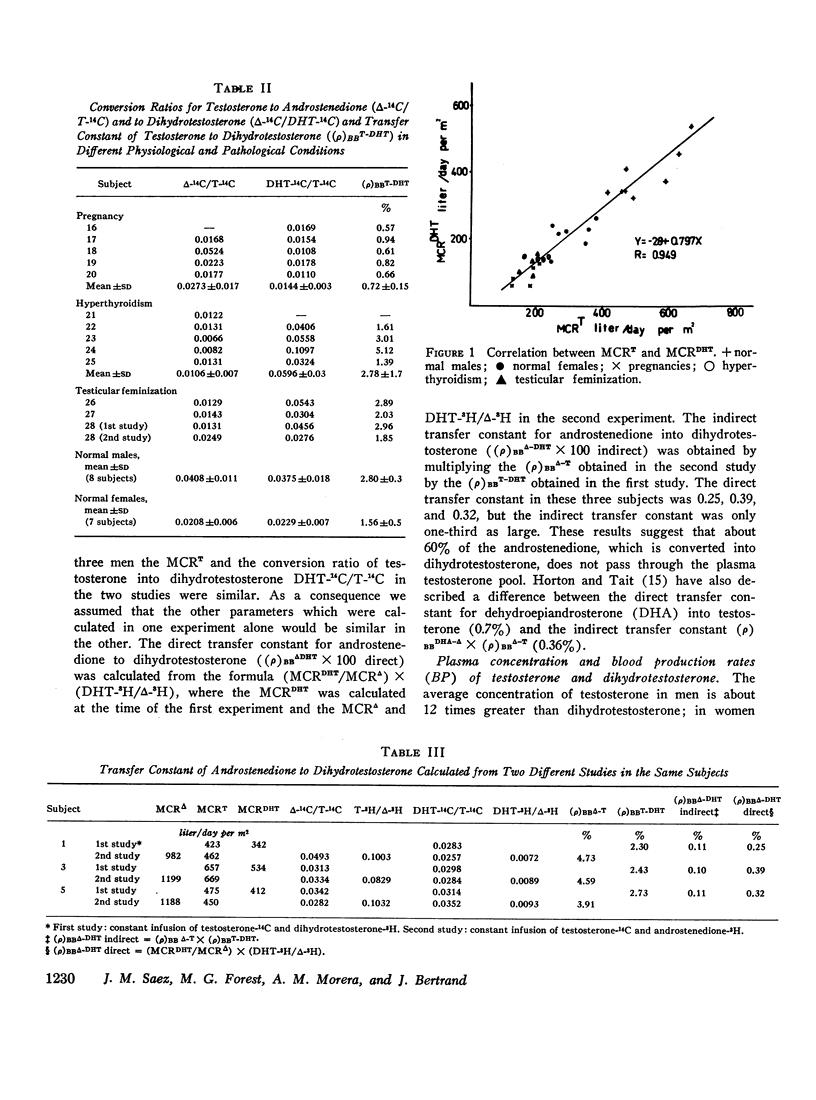
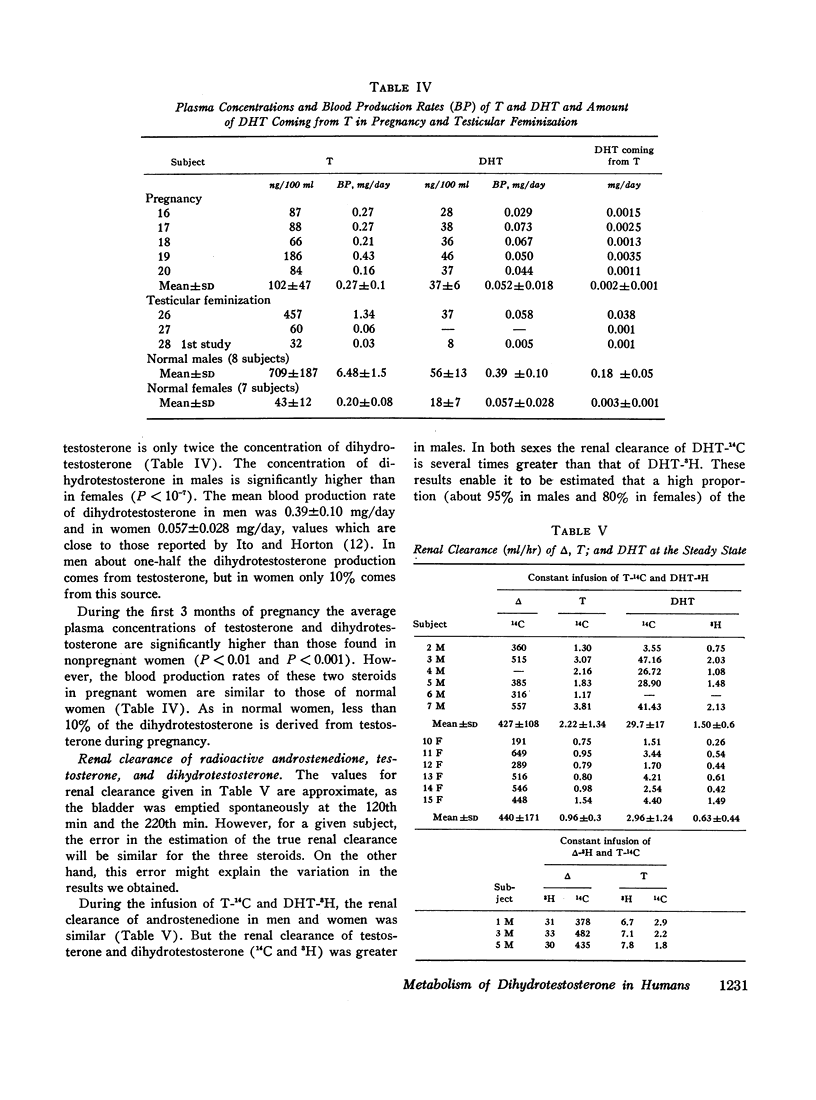
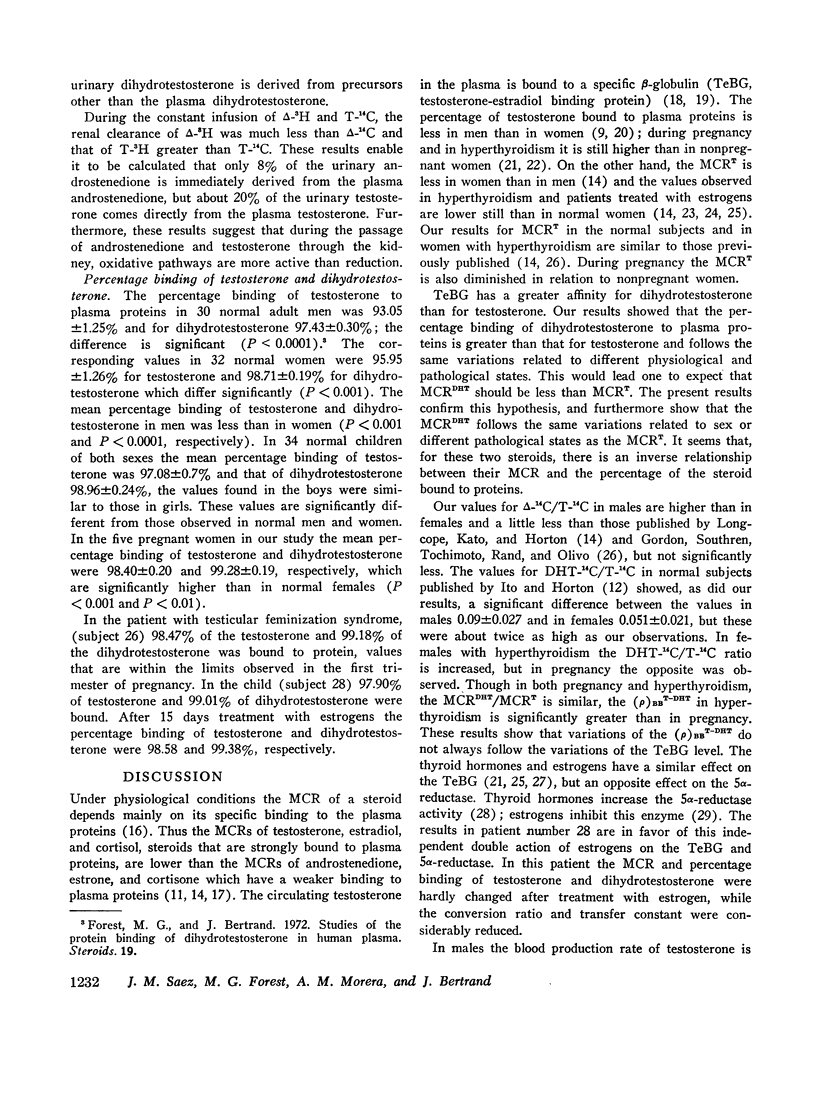
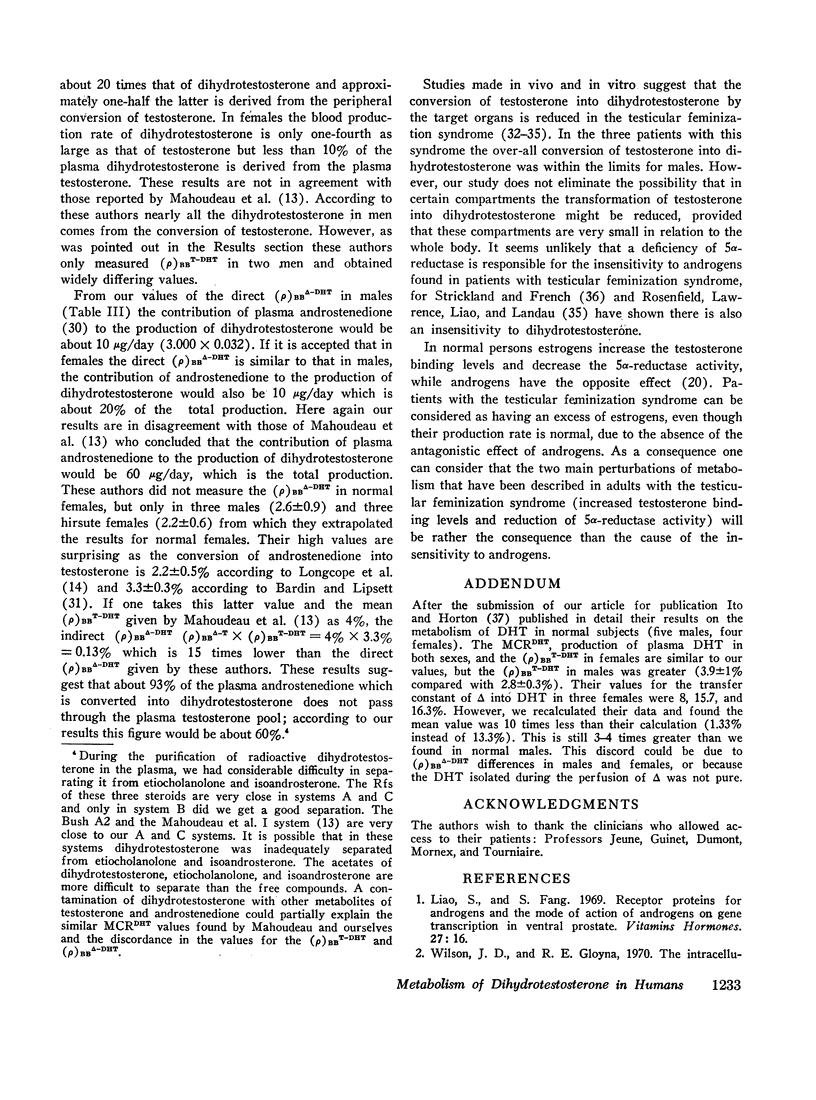
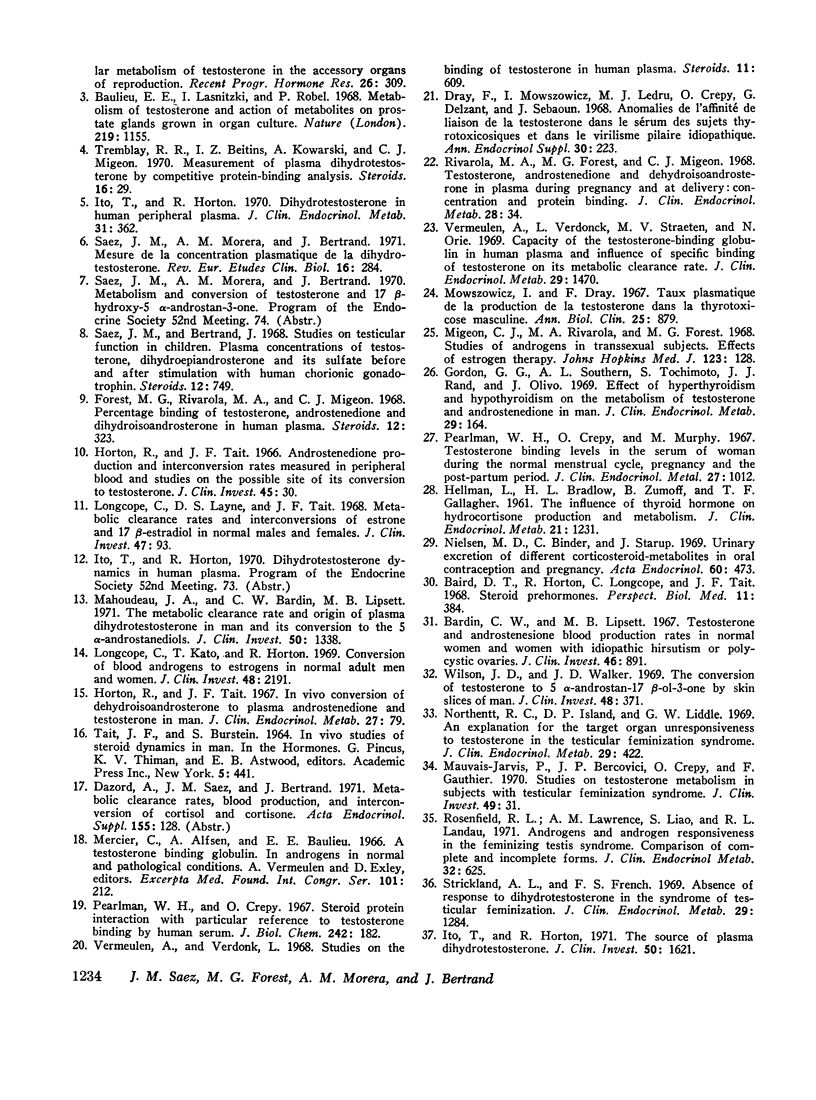
Selected References
These references are in PubMed. This may not be the complete list of references from this article.
- Baird D., Horton R., Longcope C., Tait J. F. Steroid prehormones. Perspect Biol Med. 1968 Spring;11(3):384–421. doi: 10.1353/pbm.1968.0053. [DOI] [PubMed] [Google Scholar]
- Bardin C. W., Lipsett M. B. Testosterone and androstenedione blood production rates in normal women and women with idiopathic hirsutism or polycystic ovaries. J Clin Invest. 1967 May;46(5):891–902. doi: 10.1172/JCI105588. [DOI] [PMC free article] [PubMed] [Google Scholar]
- Baulieu E. E., Lasnizki I., Robel P. Metabolism of testosterone and action of metabolites on prostate glands grown in organ culture. Nature. 1968 Sep 14;219(5159):1155–1156. doi: 10.1038/2191155a0. [DOI] [PubMed] [Google Scholar]
- Dray F., Mowszowicz I., Ledru M. J., Crépy O., Delzant G., Sebaoun J. Anomalies de l'affinité de liaison de testostérone dans le sérum des sujets thyrotoxicosiques et dans le virilisme pilaire idiopathique. Augmentation de l'affinité de liaison après administration d'hormones thyroïdiennes, chez le sujet dont l'affinité est normale ou basse. Ann Endocrinol (Paris) 1969;30(Suppl):223–232. [PubMed] [Google Scholar]
- Forest M. G., Rivarola M. A., Migeon C. J. Percentage binding of testosterone, androstenedione and dehydroisoandrosterone in human plasma. Steroids. 1968 Sep;12(3):323–343. doi: 10.1016/0039-128x(68)90025-1. [DOI] [PubMed] [Google Scholar]
- Gordon G. G., Southren A. L., Tochimoto S., Rand J. J., Olivo J. Effect of hyperthyroidism and hypothyroidism on the metabolism of testosterone and androstenedione in man. J Clin Endocrinol Metab. 1969 Feb;29(2):164–170. doi: 10.1210/jcem-29-2-164. [DOI] [PubMed] [Google Scholar]
- HELLMAN L., BRADLOW H. L., ZUMOFF B., GALLAGHER T. F. The influence of thyroid hormone on hydrocortisone production and metabolism. J Clin Endocrinol Metab. 1961 Oct;21:1231–1247. doi: 10.1210/jcem-21-10-1231. [DOI] [PubMed] [Google Scholar]
- Horton R., Tait J. F. In vivo conversion of dehydroisoandrosterone to plasma androstenedione and testosterone in man. J Clin Endocrinol Metab. 1967 Jan;27(1):79–88. doi: 10.1210/jcem-27-1-79. [DOI] [PubMed] [Google Scholar]
- Ito T., Horton R. Dihydrotestosterone in human peripheral plasma. J Clin Endocrinol Metab. 1970 Oct;31(4):362–368. doi: 10.1210/jcem-31-4-362. [DOI] [PubMed] [Google Scholar]
- Ito T., Horton R. The source of plasma dihydrotestosterone in man. J Clin Invest. 1971 Aug;50(8):1621–1627. doi: 10.1172/JCI106650. [DOI] [PMC free article] [PubMed] [Google Scholar]
- Longcope C., Kato T., Horton R. Conversion of blood androgens to estrogens in normal adult men and women. J Clin Invest. 1969 Dec;48(12):2191–2201. doi: 10.1172/JCI106185. [DOI] [PMC free article] [PubMed] [Google Scholar]
- Longcope C., Layne D. S., Tait J. F. Metabolic clearance rates and interconversions of estrone and 17beta-estradiol in normal males and females. J Clin Invest. 1968 Jan;47(1):93–106. doi: 10.1172/JCI105718. [DOI] [PMC free article] [PubMed] [Google Scholar]
- Mahoudeau J. A., Bardin C. W., Lipsett M. B. The metabolic clearance rate and origin of plasma dihydrotestosterone in man and its conversion to the 5-alpha-androstanediols. J Clin Invest. 1971 Jun;50(6):1338–1344. doi: 10.1172/JCI106613. [DOI] [PMC free article] [PubMed] [Google Scholar]
- Mauvais-Jarvis P., Bercovici J. P., Crepy O., Gauthier F. Studies on testosterone metabolism in subjects with testicular feminization syndrome. J Clin Invest. 1970 Jan;49(1):31–40. doi: 10.1172/JCI106219. [DOI] [PMC free article] [PubMed] [Google Scholar]
- Migeon C. J., Rivarola M. A., Forest M. G. Studies of androgens in transsexual subjects. Effects of estrogen therapy. Johns Hopkins Med J. 1968 Sep;123(3):128–133. [PubMed] [Google Scholar]
- Mowszowicz I., Dray F. Taux plasmatique de la production de la testostérone dans la thyrotoxicose masculine. Ann Biol Clin (Paris) 1967 Jul-Sep;25(7):879–888. [PubMed] [Google Scholar]
- Nielsen M. D., Binder C., Starup J. Urinary excretion of different corticosteroid-metabolites in oral contraception and pregnancy. Acta Endocrinol (Copenh) 1969 Mar;60(3):473–485. doi: 10.1530/acta.0.0600473. [DOI] [PubMed] [Google Scholar]
- Northcutt R. C., Island D. P., Liddle G. W. An explanation for the target organ unresponsiveness to testosterone in the testicular feminization syndrome. J Clin Endocrinol Metab. 1969 Mar;29(3):422–425. doi: 10.1210/jcem-29-3-422. [DOI] [PubMed] [Google Scholar]
- Pearlman W. H., Crépy O., Murphy M. Testosterone-binding levels in the serum of women during the normal menstrual cycle, pregnancy, and the post-partum period. J Clin Endocrinol Metab. 1967 Jul;27(7):1012–1018. doi: 10.1210/jcem-27-7-1012. [DOI] [PubMed] [Google Scholar]
- Pearlman W. H., Crépy O. Steroid-protein interaction with particular reference to testosterone binding by human serum. J Biol Chem. 1967 Jan 25;242(2):182–189. [PubMed] [Google Scholar]
- Rivarola M. A., Forest M. G., Migeon C. J. Testosterone, androstenedione and dehydroepiandrosterone in plasma during pregnancy and at delivery: concentration and protein binding. J Clin Endocrinol Metab. 1968 Jan;28(1):34–40. doi: 10.1210/jcem-28-1-34. [DOI] [PubMed] [Google Scholar]
- Rosenfield R. L., Lawrence A. M., Liao S., Landau R. L. Androgens and androgen responsiveness in the feminizing testis syndrome. Comparison of complete and "incomplete" forms. J Clin Endocrinol Metab. 1971 May;32(5):625–632. doi: 10.1210/jcem-32-5-625. [DOI] [PubMed] [Google Scholar]
- Saez J. M., Bertrand J. Studies on testicular function in children: plasma concentrations of testosterone, dehydroepiandrosterone and its sulfate before and after stimulation with human chorionic gonadotrophin. (1). Steroids. 1968 Dec;12(6):749–761. doi: 10.1016/s0039-128x(68)80029-7. [DOI] [PubMed] [Google Scholar]
- Saez J. M., Morera A. M., Bertrand J. Mesure de la concentration plasmatique de la dihydro-testosterone. Rev Eur Etud Clin Biol. 1971 Mar;16(3):284–287. [PubMed] [Google Scholar]
- Strickland A. L., French F. S. Absence of response to dihydrotestosterone in the syndrome of testicular feminization. J Clin Endocrinol Metab. 1969 Sep;29(9):1284–1286. doi: 10.1210/jcem-29-9-1284. [DOI] [PubMed] [Google Scholar]
- Tremblay R. R., Beitins I. Z., Kowarski A., Migeon C. J. Measurement of plasma dihydrotestosterone by competitive protein-binding analysis. Steroids. 1970 Jul;16(1):29–40. doi: 10.1016/s0039-128x(70)80093-9. [DOI] [PubMed] [Google Scholar]
- Vermeulen A., Verdonck L. Studies on the binding of testosterone to human plasma. Steroids. 1968 May;11(5):609–635. [PubMed] [Google Scholar]
- Wilson J. D., Walker J. D. The conversion of testosterone to 5 alpha-androstan-17 beta-ol-3-one (dihydrotestosterone) by skin slices of man. J Clin Invest. 1969 Feb;48(2):371–379. doi: 10.1172/JCI105994. [DOI] [PMC free article] [PubMed] [Google Scholar]


